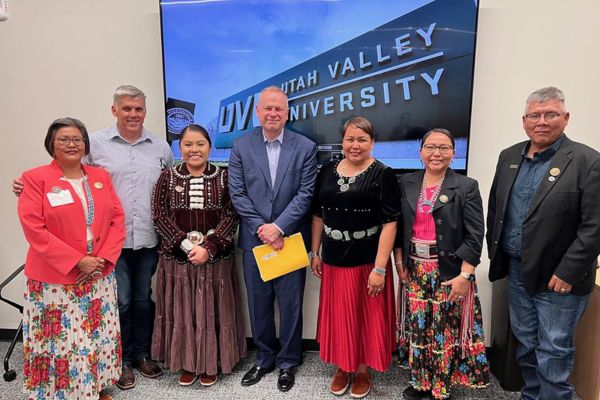
- Details
- By Native News Online Staff
The 25th Navajo Nation Nation Council convened last week during the 17th Annual Governor’s Native American Summit in Orem, Utah, to discuss advancing ongoing efforts to connect two communities in the nation with a paved roadway.
The two communities, Navajo Mountain and Oljato, are located in the western portion of the Navajo Nation and are approximately 30 miles apart. The only paved route to get from one community to another requires residents and other commuters to travel over 100 miles through rough terrain that often involves the use of four-wheel drive vehicles.
The meeting focused on two possible routes that would improve transportation efficiency, drive economic growth and tourism opportunities, improve emergency response time and access to services, and significantly improve the quality of life for many locals.
“Many residents, including elders, commute through these rough roads for long hours each day for basic services and necessities, hauling water for their families and livestock, and going to school and work,” Navajo Nation Council Delegate Herman M. Daniels said in a statement. “If we pave a roadway, it would also increase tourism in the area and create jobs and revenue for the Navajo Nation, the counties, and the entire state of Utah. This project will require significant investments, but it will create additional benefits in the long-term.”
According to a statement from the Navajo Nation Council, emergency response time for the impacted region is anywhere from two hours to three days, depending on the weather and road conditions.
The committee is continuing to gather data on loss of life due to slow emergency response times — with an emphasis on the COVID-19 pandemic — to underscore the need for the paved road.
According to a statement from Navajo Division of Transportation Roads Manager Joe Peterman, the Navajo Nation receives approximately $52 million annually from federal highway funding, with $36 million allocated for road construction for the entire Navajo Nation, which spans more than 27,000 square miles.
Paving the roadway between Navajo Mountain and Oljato could range from approximately $161 million to $186 million, according to a statement from the Navajo Nation Council. At last week’s council meeting, delegates determined that funding needs to be identified for a development plan and environmental impact study.
Council Speaker Crystalyne Curley said securing funds and completing the project will require buy-in from multiple levels of government.
“The Navajo Nation Council will continue working closely with the stakeholders to secure funds and other resources,” Curley said in a statement. “To move the project forward, it will be challenging and will require support and input from many of our county, state, and federal partners.”
More Stories Like This
Native News Weekly (August 25, 2024): D.C. BriefsUS Presidents in Their Own Words Concerning American Indians
Montana County Redraws District After Settlement to Ensure Chippewa Cree Votes Count
Tunica-Biloxi Council Member Named to Tribal Leadership Foundation
Ethics Complaint Alleges Former Navajo Nation Chief of Staff Accepted Gifts From Contractor
Help us defend tribal sovereignty.
At Native News Online, our mission is rooted in telling the stories that strengthen sovereignty and uplift Indigenous voices — not just at year’s end, but every single day.
Because of your generosity last year, we were able to keep our reporters on the ground in tribal communities, at national gatherings and in the halls of Congress — covering the issues that matter most to Indian Country: sovereignty, culture, education, health and economic opportunity.
That support sustained us through a tough year in 2025. Now, as we look to the year ahead, we need your help right now to ensure warrior journalism remains strong — reporting that defends tribal sovereignty, amplifies Native truth, and holds power accountable.
 The stakes couldn't be higher. Your support keeps Native voices heard, Native stories told and Native sovereignty defended.
The stakes couldn't be higher. Your support keeps Native voices heard, Native stories told and Native sovereignty defended.
Stand with Warrior Journalism today.
Levi Rickert (Potawatomi), Editor & Publisher


